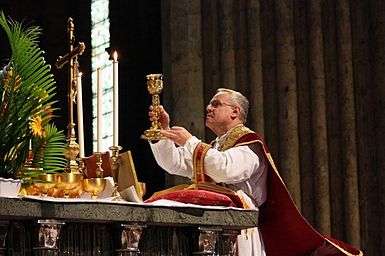Notre-Dame de Chrétienté

Notre-Dame de Chrétienté (French: Our Lady of Christendom) is a Catholic lay non-profit organization based in Versailles, France, which organises an annual pilgrimage from Notre-Dame de Paris to Notre-Dame de Chartres occurring around the Christian feast of Pentecost. Although the pilgrimage has existed since 1983, the organisation was not founded until 2000.
The pilgrimage characteristically use of the extraordinary form of the Roman rite of the Catholic Church.
At Pentecost in 2007, for the 25th anniversary of the pilgrimage, and following the announcement of the motu proprio letter Summorum Pontificum on the traditional liturgy of the Church,[1] there were nearly ten thousand pilgrims in Chartres on May 28, despite the difficult weather conditions.[2]
History

Even before the Gothic cathedral was built, Chartres was a place of pilgrimage. By the end of the 12th century, the church had become one of the most important popular pilgrimage destinations in Europe. However, it was at a different pilgrimage to the tomb of Fr. Emmanuel in Mesnil-Saint-Loup[3] when the traditionalist Catholic organization centre Henri et André Charlier had the idea to organize a traditional pilgrimage between the cathedrals of Paris and Chartres. The pilgrimage gradually increased in popularity, reaching ten thousand pilgrims in 1988.
Controversy
In 1988, traditionalist priest Marcel Lefebvre consecrated four priests as bishops without the approval of Pope John Paul II, an act of schism which split the traditionalist community in two. Thus, in 1989, two pilgrimages were organised: one called "Pèlerinage de Chrétienté" (Pilgrimage of Christendom) from Paris to Chartres, and the other called "Pèlerinage de Tradition" (Pilgrimage of Tradition) from Chartres to Paris.[4]
Themes
- 2016 : Viens, Esprit-Saint (Come, Holy Spirit)
- 2015 : Jésus-Christ sauveur du monde (Jesus Christ saviour of the world)
- 2014 : Au commencement, Dieu créa le Ciel et la terre (In the beginning God created the Heaven and the earth)
- 2013 : Education, chemin de sainteté (Education, the way of holiness)
- 2012 : Famille, berceau de la Chrétienté (Family, the cradle of Christendom)
- 2011 : L'Évangile de la vie (The Gospel of life)
- 2010 : L'Église est notre Mère (The Church is our Mother)
- 2009 : Que votre règne arrive (Thy kingdom come)
- 2008 : Chez nous, soyez Reine (Among us, be Queen)
- 2007 : Les marcheurs de Dieu (God's walkers)
- 2006 : Aimer, c'est tout donner (To love is to give all)
- 2005 : Notre-Dame, rempart de la chrétienté (Our Lady, bulwark of Christendom)
- 2004 : Un seul Seigneur, une seule foi, un seul baptême (One Lord alone, one faith alone, one baptism alone)
- 2003 : Chrétienté, vocation de la France (Christendom, calling of France)
- 2002 : Chrétienté, chemin de sainteté (Christendom, way of holiness)
- 2001 : Chrétienté, source de vie (Christendom, source of life)
- 2000 : La messe, cœur de la Chrétienté (The mass, heart of Christendom)
- 1999 : Que votre règne arrive (Thy kingdom come)
- 1998 : Esprit-Saint, Dieu de Force et de Sagesse (Holy Spirit, God of Strength and Wisdom)
- 1997 : Jésus-Christ, salut des nations (Jesus Christ, health of nations)
- 1996 : France, es-tu fidèle aux promesses de ton baptême? (France, are you faithful to your baptismal promises?)
- 1995 : France, éducatrice des peuples (France, teacher of peoples)
- 1994 : France, Fille aînée de l'Église (France, eldest daughter of the Church)
- 1993 : Pour que France, pour que Chrétienté continue (That France, that Christendom may continue)
- 1992 : Dieu premier servi (God served first)
- 1991 : Le Christ, notre liberté (Christ, our freedom)
- 1990 : Vers Notre-Dame de l'Europe de la Foi (Toward Our Lady of Europe of Faith)
- 1989 : Pélerinage du cœur et de la Croix (Pilgrimage of the heart and of the Cross)
- 1988 : Notre-Dame de Fatima—Espérance du Monde (Our Lady of Fatima—Hope of the World)
- 1987 : Demain la Chrétienté (Tomorrow Christendom)
- 1986 : Avec Notre-Dame (With Our Lady)
- 1985 : La famille, avenir de la Chrétienté (The family, the future of Christendom)
- 1984 : Pour la rédemption de la France (For the redemption of France)
- 1983 : Pour le renouveau de la jeunesse de France (For the renewal of the youth of France)


